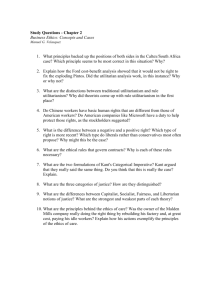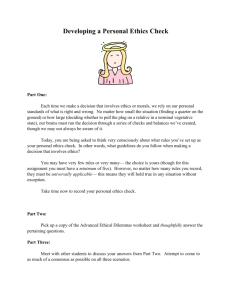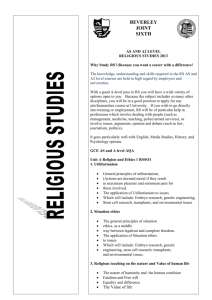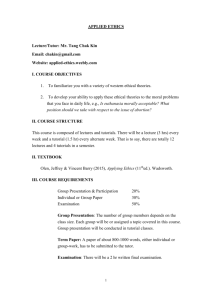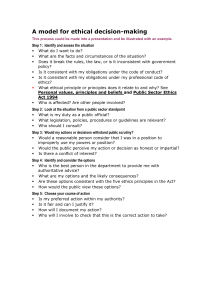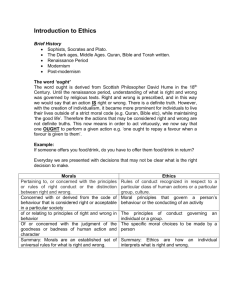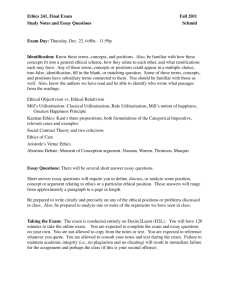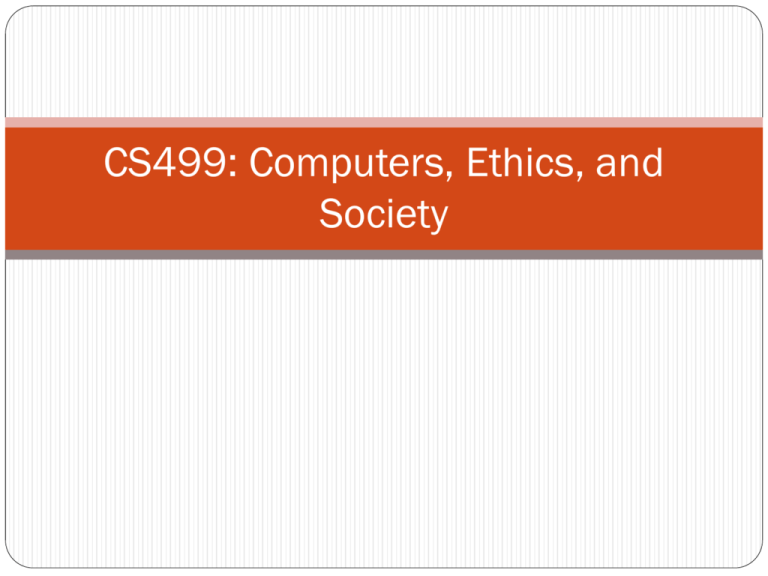
CS499: Computers, Ethics, and
Society
Syllabus
BBVista (check for course updates regularly – at least once per
day!)
Course website:
https://www.cis.uab.edu/cs499/spring2012/1D
Book
Computers, Ethics, and Society: Ermann and Shauf, Oxford, ISBN 0-19-514302-7, 2003.
Recommended Book
Structure of Scientific Revolutions,T. Kuhn, Chicago, 3/e.
Wiki Page:
http://en.wikipedia.org/wiki/The_Structure_of_Scientific_Revolutions
Google Book Review:
http://books.google.com/books?id=xnjS401VuFMC&sitesec=reviews&rf=st:us
Syllabus (cont.)
Course Schedule:
Faculty and guest lecturers will hold class each week.
The Major Field Test Examination is taken as a required part of the
course.
Course Objectives:
A review of key concepts in the undergraduate level study of
computer science. All professors in the department participate in
giving at least one lecture each (under normal circumstances). Some
may lecture more than once.
A discussion of various aspects of Computer Ethics.
Discussion of “Scientific Thought” and philosophy.
Oral and written communication/presentation about Ethics in
Computer Science Required.
Syllabus (cont.)
Grading:
The Major Field Test is a requirement, but undergraduates don’t have to
get a specific grade on it to pass CS 499. It is a learning outcomes
measurement.
Presentation Summaries (10*25 = 250 points)You must turn in ten
or more one-page (200-250 word) summaries of CS499 lectures you have
attended (or departmental lectures, with instructor’s permission to
substitute). These are lectures by the faculty. Faculty lecturing twice (e.g.,
two days lecture) on same subject, you can only use for a single summary.
Term Paper (225 points total)You must write a five-to-seven page
(approximately 1500-1800 word) essay about computer ethics based on
readings at the end of the term (see below). Additional assignment rules
and intermediate assignments (title abstract, etc.) plus instructions to be
provided. Correct citation, use of sources, strategy, for written and verbal
presentation all count towards the grade.
Syllabus (cont.)
Grading (cont.)
Second paper (200 points) A five-page write-up (1250-
1500 words) on “Structure of Scientific Revolutions” or other
pre-approved will be required. Grading will include emphasis
on grammar, style, quality of writing and relevance of
presentation. Due before the Spring Break.
Presentation of one of your papers (175 points)You
must make a 15-minute presentation on one of your papers.
PowerPoint slides are required. Detailed instructions to be
provided. This is either the ethics paper, or the “other preapproved topic paper.”
Class Participation (100 points). Attendance and active
participation.
Syllabus (cont.)
Late Submission:
All assignments are due as indicated on BBVista. Any assignment
turned in after this deadline is considered late. Late assignments
will lose 10% for every 24-hour period, up to a maximum of
50% (weekends and holidays count as one 24-hour period). Any
assignment submitted after expiration of time supported on
BBVista will receive a score of zero.
See BBVista for due dates of the reviews of presentations and
the presentation summaries.
All required assignments must be turned in even if
they are late to pass this course. Failure to submit any
assignments will result in a grade of ‘F’ for the course.
Syllabus (cont.)
Class Attendance:
Attendance is mandatory for this course. If you know you will
be absent for a legitimate reason, let the instructor know. If you
are sick bring a doctor's excuse or a written university excuse
to resolve the absence(s). An absence has to be resolved as soon
as possible - otherwise it will not be treated as an excused
absence.
The Major Field Test information is documented on BBVista.
You must register for the test.
Syllabus (cont.)
Academic Honesty:
Any student who violates the university's academic honesty
policy will be reported for academic discipline. All university
and department policies related to students are included here
by implication.
IMPORTANT: All papers and summaries will be submitted to
Turnitin for comparison against the most comprehensive digital
repository of potentially plagiarizable material in the world!
Cheating will not be tolerated
You must do your own homework
It is acceptable to discuss the reading assignments and general
approaches to solving homework problems with your
classmates
It is not acceptable to discuss detailed homework answers or
to copy homework answers from other students
Hopefully you already knew this….
Plagiarism includes, but is not
limited to
Failure to indicate the source with quotation
marks or footnotes where appropriate if any of
the following are reproduced in the work
submitted by a student:
1.
2.
3.
4.
5.
A written phrase.
A graphic element.
A proof.
Specific language.
An idea derived from the work, published or
unpublished, of another person.
Avoiding plagiarism
If you use someone’s specific words, put them in quotes and
cite the source.
If you use someone’s ideas expressed in your own words, cite
the source.
If you paraphrase, summarize in your own words, but still
cite source
Don’t use the same sentence structure with a few word substitutions
If you use some of the source’s words, put them in quotes.
When in doubt, put it in quotes and cite the source!
Good resource on avoiding plagiarism
http://www.wisc.edu/writing/Handbook/QPA_plagiarism.html
Includes nice examples of good and bad paraphrasing
11
Syllabus (cont.)
E-mail:
Every student will be required to use his/her official email
address that is blazerid@uab.edu. New students must login and
configure their email addresses. For more details on obtaining
blazerid and configuring email please see:
http://www.uab.edu/blazerid.
Key email communications will be made using this address. You
must regularly log in to BBVista, since emails will also be sent
there and they do not forward. Assignments and information
will appear only there.
Assignment schedule
Term paper topic due: Mar. 16th
Term paper due: Apr. 16th
Second paper due: Mar. 16th
Second paper topic due: Feb. 17th
Presentation summary due:
Feb. 20th: three summaries due
Mar. 26th: four summaries due
Apr. 30th: three summaries due
Term presentations:
Apr. 23, 25, 27, and 30 (3 presentations in each session)
Why study ethics?
Ethical analysis can provide a structured way to evaluate an
issue and choose a course of action
Ethical analysis can help illuminate multiple sides of an issue
Ethical analysis can help produce persuasive arguments
In your personal and professional life you will confront
difficult decisions
14
What is computer ethics
Problems:
Internet Privacy
Spyware
Browser cookies
Wikileaks …
Core issues:
Professional responsibility, intellectual property rights, privacy,
censorship, and the impact of technology in society
Social responsibility
No lecture on 13th but you need to do the required readings
Reading list will be uploaded to BBVista by tonight.
Lecture schedule for next two weeks:
Jan. 16: MLK day (no class)
Jan. 18: Gary Warner (Computer Forensics)
Jan. 20th: Wei-Bang Chen (Spam Image Mining)
Jan. 23rd: ACM distinguished lecture – Software Economics
2:30 – 3:30pm, HUC Auditorium
Meeting with students (4pm – 4:40pm)
A Sample Scenario
You are the senior software engineer at start-up
developing software for handheld computers to help
nurses keep track of patients
Sales force has promised product by next week
Product still contains many minor bugs
No major bugs have been found, but QA recommends
another month of testing
A competitor plans to release a similar product in a few
weeks
If your product is not the first to market your start-up
will probably go out of business
Should you recommend release of the product next week?
Who will benefit if the company follows your
recommendation?
Who will be harmed if the company follows your
recommendation?
Do you have an obligation to any group of people that may be
affected by your decision?
Subjective Relativism
Relativism
No universal norms of right and wrong
One person can say “X is right,” another can say “X is wrong,”
and both can be right
Subjective relativism
Each person decides right and wrong for himself or herself
“What’s right for you may not be right for me”
Source: Slides for Chapter 2 of Ethics for the Information Age by Michael J. Quinn. Copyright © 2005 Pearson Addison-Wesley. All rights reserved.20
Subjective relativism evaluation of spam
Spammers say spam is good
Spam brings advertisements to the attention of some people
who want to buy their products
Spammers make money
Purchasers are happy to buy their products (true?)
Most spam recipients and ISPs say spam is bad
Spam wastes time and computer resources, congests networks,
slows processing of non-spam email
21
Case for Subjective Relativism
Well-meaning and intelligent people often disagree on moral
issues
One example is self-plagiarism – a non ending battle
Ethical debates are often disagreeable and pointless
Source: Slides for Chapter 2 of Ethics for the Information Age by Michael J. Quinn. Copyright © 2005 Pearson Addison-Wesley. All rights reserved.22
Case Against Subjective Relativism
Blurs distinction between doing what you think is right and
doing what you want to do
Makes no moral distinction between the actions of different
people
SR and tolerance are two different things
Decisions may not be based on reason
Not a workable ethical theory
Source: Slides for Chapter 2 of Ethics for the Information Age by Michael J. Quinn. Copyright © 2005 Pearson Addison-Wesley. All rights reserved.23
Case for Kantianism
Rational
Produces universal moral guidelines
Treats all persons as moral equals
Workable ethical theory
Source: Slides for Chapter 2 of Ethics for the Information Age by Michael J. Quinn. Copyright © 2005 Pearson Addison-Wesley. All rights reserved.24
Case Against Kantianism
Sometimes no rule adequately characterizes an action.
There is no way to resolve a conflict between rules.
Monogamy vs Polygamy
Kantianism allows no exceptions to moral laws.
Source: Slides for Chapter 2 of Ethics for the Information Age by Michael J. Quinn. Copyright © 2005 Pearson Addison-Wesley. All rights reserved.25
Utilitarianism
Jeremy Bentham and John Stuart Mill
An action is good if it benefits someone
An action is bad if it harms someone
Utility: tendency of an object to produce happiness or
prevent unhappiness for an individual or a community
Happiness = advantage = benefit = good = pleasure
Unhappiness = disadvantage = cost = evil = pain
Source: Slides for Chapter 2 of Ethics for the Information Age by Michael J. Quinn. Copyright © 2005 Pearson Addison-Wesley. All rights reserved.26
Principle of Utility
(Greatest Happiness Principle)
An action is right (or wrong) to the extent
that it increases (or decreases) the
total happiness of the affected parties.
Source: Slides for Chapter 2 of Ethics for the Information Age by Michael J. Quinn. Copyright © 2005 Pearson Addison-Wesley. All rights reserved.27
Act Utilitarianism
Utilitarianism
Morality of an action has nothing to do with intent
Focuses on the consequences
A consequentialist theory
Act utilitarianism
Add up change in happiness of all affected beings
Sum > 0, action is good
Sum < 0, action is bad
Source: Slides for Chapter 2 of Ethics for the Information Age by Michael J. Quinn. Copyright © 2005 Pearson Addison-Wesley. All rights reserved.28
Bentham: Weighing Pleasure/Pain
Intensity
Duration
Certainty
Propinquity
Fecundity
Purity
Extent
Source: Slides for Chapter 2 of Ethics for the Information Age by Michael J. Quinn. Copyright © 2005 Pearson Addison-Wesley. All rights reserved.29
Highway Routing Scenario
State may replace a curvy stretch of highway
New highway segment 1 mile shorter (benefit)
150 houses would have to be removed (cost)
Some wildlife habitat would be destroyed (cost)
Source: Slides for Chapter 2 of Ethics for the Information Age by Michael J. Quinn. Copyright © 2005 Pearson Addison-Wesley. All rights reserved.30
Evaluation
Costs
$20 million to compensate homeowners
$10 million to construct new highway
Lost wildlife habitat worth $1 million
Benefits
$39 million savings in automobile driving costs
Conclusion
Benefits exceed costs
Building highway a good action
Source: Slides for Chapter 2 of Ethics for the Information Age by Michael J. Quinn. Copyright © 2005 Pearson Addison-Wesley. All rights reserved.31
Act utilitarian evaluation of spam
A spammer sent a spam email to 100 million people
1 in 10,000 buy product
90% of people who buy product are happy with it, other
10% feel ripped off
People who don’t buy product waste time and money,
get annoyed, etc. - unhappy
Spammer makes lots of money and is VERY happy
9001 happy people, 99,990,000 unhappy people
Conclusion: 99.991% of people are unhappy, so spam is
wrong
32
Case for Act Utilitarianism
Focuses on happiness
Down-to-earth (practical)
Comprehensive (??)
Workable ethical theory
Source: Slides for Chapter 2 of Ethics for the Information Age by Michael J. Quinn. Copyright © 2005 Pearson Addison-Wesley. All rights reserved.34
Case Against Act Utilitarianism
Unclear whom to include in calculations
Too much work
Ignores our innate sense of duty
Susceptible to the problem of moral luck
An example:
China's Three Gorges Dam: An
Environmental Catastrophe?
http://www.scientificamerican.com/a
rticle.cfm?id=chinas-three-gorgesdam-disaster
Sometimes actions do not have
intended consequences - Moral
worth of action is dependent on
consequences that may not be under
control of moral agent
35
Rule Utilitarianism
We ought to adopt moral rules which, if followed by
everyone, will lead to the greatest increase in total happiness
Act utilitarianism applies Principle of Utility to individual
actions
Rule utilitarianism applies Principle of Utility to moral rules
36
Anti-Worm Scenario
August 2003: Blaster worm infected thousands of Windows
computers
Soon after, Nachi worm appeared
Took control of vulnerable computers
Located and destroyed copies of Blaster
Downloaded software patch to fix security problem
Used computers as launching pad to try to “infect” other
vulnerable PCs
37
Evaluation using Rule Utilitarianism
Proposed rule: If I can write a helpful worm that removes a
harmful worm from infected computers and shields them from
future attacks, I should do so ???
Who would benefit
People who do not keep their systems updated
Who would be harmed
People who use networks
People who’s computers are invaded by buggy anti-worms
System administrators
Conclusion: Harm outweighs benefits. Releasing anti-worm is
wrong.
38
Case for Rule Utilitarianism
Compared to act utilitarianism, it is easier to perform the
utilitarian calculus.
Not every moral decision requires performing utilitarian
calculus.
Moral rules survive exceptional situations
Avoids the problem of moral luck
Workable ethical theory
39
Case Against Utilitarianism in General
All consequences must be measured on a single scale.
Intangible benefits/costs (must be expressed in dollars?)
Utilitarianism ignores the problem of an unjust distribution
of good consequences.
Utilitarianism does not mean “the greatest good of the greatest
number”
That requires a principle of justice
What happens when a conflict arises between the Principle of
Utility and a principle of justice?
Greatest amount of good VS distribute the good as widely as possible ?
40
James Rachels’ Definition (Social
Contract Theory)
“Morality consists in the set of rules,
governing how people are to
treat one another, that rational
people will agree to accept, for their
mutual benefit, on the condition that
others follow those rules as well.”
42
People act out of self-interest w/out agreement
Morality is the result of an implicit agreement among
rational beings who understand that there is a tension
between self-interest and the common good
The common good is best realized when everyone cooperates
Cooperation occurs when those acting selfishly suffer
negative consequences
Examples: Recycling, energy conservation
43
Kinds of Rights
Negative right: A right that another can guarantee by leaving
you alone
Positive right: A right obligating others to do something on
your behalf
Absolute right: A right guaranteed without exception
Limited right: A right that may be restricted based on the
circumstances
Source: Slides for Chapter 2 of Ethics for the Information Age by Michael J. Quinn. Copyright © 2005 Pearson Addison-Wesley. All rights reserved.44
John Rawls’s Principles of Justice
Each person may claim a “fully adequate” number of basic
rights and liberties, so long as these claims are consistent
with everyone else having a claim to the same rights and
liberties
Any social and economic inequalities must
Be associated with positions that everyone has a fair and equal
opportunity to achieve
Be to the greatest benefit of the least-advantaged members of
society (the difference principle)
Source: Slides for Chapter 2 of Ethics for the Information Age by Michael J. Quinn. Copyright © 2005 Pearson Addison-Wesley. All rights reserved.45
Social contract theory evaluation of spam
Everyone has right to free speech
You can send email to anyone you want
No requirement that people listen to your speech
People can send you angry replies if they don’t like your email
If 99,990,000 people are unhappy with a spam message,
they should be able to send an angry reply to the
spammer, which should have cost to spammer
But spammers forge headers so they do not get angry
replies
This violates social contract, thus spamming is wrong
46
http://r20.rs6.net/tn.jsp?llr=tsagrkfab&et=1109194333284&s=1637&e=001cBGW9zAdR_6
M8XJB2Ov-UnxI0gL3WO3HDXrBZdyfNEIWqb63OgG6_8XtK0I3Jkk72K5ya1gXaowwLtTtOSiZ62ARQOBWkA821Lb852LvxI=
Case for Social Contract Theory
Framed in language of rights
Principle of Justice
Explains why people act in self-interest without common
agreement
Provides clear analysis of certain citizen/government
problems
E.g., it provides a logical explanation of why it is morally
acceptable to punish someone for a crime.
Workable ethical theory
48
Case Against Social Contract Theory
No one signed contract
Some actions have multiple characterizations
Conflicting rights problem
May unjustly treat people who cannot uphold contract
What about people who, though no fault of their own, are
unable to follow the moral rules?
49
Mail Abuse Prevention System
MAPS is a not-for-profit organization
Contacts marketers who violate MAPS standards for
bulk email
Puts marketers who violate standards on a Realtime
Blackhole List (RBL)
Some mail relays refer to RBL list
Looks up email host name on RBL list
If name on list, the email gets bounced back
All email from blacklisted hosts gets bounced, even
email from non-spammers
51
Was the creation of the RBL ethical?
Utilitarian evaluation:
ISP using RBL benefits by getting better network performance, fewer angry
users
But their users are unable to receive email from innocent users of blacklisted
ISPs, reducing their utility
Innocent users of blacklisted ISPs unable to communicate with ISPs that user
RBL
Conclusion depends on magnitude of benefit and ratio of blacklisted
innocent users to total email users
Kantian evaluation:
MAPS puts ISPs on RBL with goal of getting innocent users to complain and
pressure ISP to drop spammers
Innocent users are treated as means to an end
This violates Categorical imperative -> RBL is unethical
52
Research and Communication Skills
Creating a bibliography and citing sources
Do you know how to create a properly formatted
bibliography?
Why is a list of URLs not a proper bibliography?
57
Research and Communication Skills
Citing sources
Whenever you take words, images, or ideas from another source you need to
cite that source
Direct quotes and paraphrases
Images,photographs, tables, graphs
Ideas, measurements, computations
Also use citations as evidence to back up assertions
If you use somebody else’s words, you must quote them
Short excerpts appear in quotes
Long excerpts (3 or more lines) are introduced and then appear as indented text,
often in a smaller font, single spaced
If you leave out words in the middle use …
If you leave out words at the end use ….
If you substitute or add words, put them in square brackets []
If you add italics say [emphasis added]
Failure to cite sources = plagiarism
58
Research and Communication Skills
Paraphrasing
Usually paraphrasing ideas is preferable to quoting unless
Exact wording is important
You are quoting famous words
You are critiquing or comparing specific words rather than ideas
The original words say what you want to say very well and succinctly
Usually paraphrasing lets you convey an idea more succinctly
because you can focus on the part of the idea most relevant to
your paper
If you end up using some of the original words in your paraphrase,
use quotes around those words
59
Research and Communication Skills
Forms of citation
Full bibliographic citation inline
Typically used on a slide
Footnote or endnote
Used in legal writing, many books, some conferences and
journals
Inline short citation with bibliography, references cited
section, or reference list
Used by most technical conferences and journals, some books,
most dissertations
60
Research and Communication Skills
Citations in text
Format depends on style you are using
Usually a number or author and date, sometimes a page number reference
too
Citation usually goes at the end of the sentence
Privacy is not “absolute,” (Westin 1967).
Privacy is not “absolute,” [3].
If Author is mentioned, in sentence, name does not appear in
citation
Westin (1967, p. 7) claims that individuals must balance a desire for privacy
with a desire to participate in society.
Multiple citations can appear together
[3, 4, 5]
(Westin 1967; Cranor 2002)
61
Research and Communication Skills
Footnotes
Used heavily in legal writing
Usually used sparingly in technical writing
Each footnote appears only once
If you reference the same source multiple times you must
repeat the reference information, however you can abbreviate
it on second and subsequent references and use ibid to
indicate same as previous reference
62
Research and Communication Skills
Creating a bibliography
Similar rules apply to other forms of citation (footnotes,
etc.)
Pick an appropriate style and use it consistently
throughout your paper
Most conferences and journals have style requirements
Popular styles: Chicago/Turabian, MLA, APA, APSA
APA: http://www.apastyle.org/
Complete bibliographic entry includes author, title, date,
publisher, place of publication, pages, volume number,
etc.
Bibliographic entries should be ordered - usually either
alphabetically or in order referenced in the text
63
Research and Communication Skills
Word processing tools
Microsoft Word
Word has built in support for footnotes and endnotes
Use cross reference feature for numbered reference lists
Third party bibliographic add-ons may be useful
LaTeX
Built in support for footnotes and endnotes
Use Bibtex!
64
Spam / Regulating Online Speech
66
Bill of Rights
First Amendment
Congress shall make no law respecting an establishment of
religion, or prohibiting the free exercise thereof; or abridging
the freedom of speech, or of the press; or the right of the
people peaceably to assemble, and to petition the government
for a redress of grievances.
67
The Internet can’t be censored
“The Net treats censorship as damage and routes around it.”
- John Gillmore
68
Cartoon dogs are anonymous on the Internet
69
Real dogs are anonymous on the Internet too!
70
Actually, none of this is true
It is easy to adopt a pseudonym or a persona on the Internet,
but it is difficult to be truly anonymous
Identities can usually be revealed with cooperation of ISP, local
sys-admins, web logs, phone records, etc.
The Internet can put up a good fight against censorship, but
in the end there is still a lot of Internet censorship
Repressive governments and intellectual property lawyers have
been pretty successful at getting Internet content removed
Google and Wikipedia Protest Anti-Piracy Bill
http://news.discovery.com/tech/sopa-googlewikipedia-blackout-120118.html
71
Communications Decency Act
Title V of the Telecommunications Act of 1996
Prohibited Internet distribution of indecent or patently
offensive material to minors
Created restrictions for the Internet similar to broadcast
media
Introduced by Sen. James Exon (D-Nebraska)
Cited Marty Rimm study
Immediately challenged in court
Supreme Court struck down CDA in 1997 (Reno v.
American Civil Liberties Union)
72
Opposition to the CDA
Over-broad, vague, unenforceable
CDA includes “indecency standard”
Obscenity and child pornography are already illegal to distribute (child pornography
is also illegal to possess)
But indecency is defined in CDA as “any comment, request, suggestion, proposal,
image, or other communications, that, in context, depicts or describes, in terms
patently offensive as measured by contemporary community standards, sexual or
excretory activities or organs.”
What community do we look at when regulating the Internet?
Internet should not be regulated like broadcast
Law would chill free speech
Internet filters are a better solution
73
Support for the CDA
Senator James Exon (D-Nebraska), sponsor of Bill: Need to
protect children from online pornography
Laws that restrict selling porn to children in other media
should apply to the Internet
Filters are not sufficient
Parents may not be able to figure out how to use them
Children may access computers away from home
74
Platform for Internet Content Selection (PICS)
Developed by the World Wide Web Consortium
Specification for associating metadata with Internet content
Supports self-labels and third-party labels
Supports the development of many rating systems
Implemented in MS Internet Explorer and other products
76
How technology tools work
Internet
content
Web
Usenet
Email
Chat
Gopher
FTP
Person or
tool classifies
content
For what age
group is it
appropriate?
Is it educational?
Tool takes
an action
Suggest
Search
Inform
Monitor
Warn
Block
Is it fun?
77
Who does the classification?
Third-party experts
Automated tools
Evaluation of safety tools
SafeFamilies.org
GetNetWise.org
FilterReview.com
Local administrators
Content providers
Survey or vote
78
Classification scheme
Good for kids
Characteristics of
content
Bad for kids
Age suitability
Who created content
79
Rating systems and vocabularies
Math
Science
English
Spelling
History
French
Spanish
Gym
Art
Music
Drama
A
B
B+
DC
AF
A+
BC
B
80
Descriptive versus subjective
Many
variables
Few
variables
complex
simple
Subjective
Descriptive
81
Can’t derive descriptive from subjective
Characters not well developed
Gratuitous sex and violence
?
Bad acting?
Boring plot?
Bad script?
Dull characters?
Unbelievable premise?
Unoriginal?
Too much violence?
Not enough violence?
82
Scope
Web sites
FTP, gopher, etc.
Chat
Instant messaging
Newsgroups
Email
Telnet
83
Actions
Suggest
Search
Inform
Monitor
Warn
Block
84
Suggest
Recommend appropriate content for children
Search
Select content that is appropriate for children and matches a
query
Google,Yahoo: SafeSearch
86
Inform
Provide information about the content
87
Warn
Provide information about content and recommend against
accessing that content before it is displayed
88
Block
Prevent children from accessing content
Guiding Children through Information Searches on
the Internet
http://www.ils.unc.edu/daniel/214/InternetSearchEngines.html
Awesome Library - K-12 Education Directory
http://www.awesomelibrary.org/
"Over 14,000 sites have been classified into a directory, specifically
organized for teachers, students and parents. Information can be found by
browsing or searching." --Search EngineWatch
89
Monitor
Record for later inspection a list of the content accessed or
attempted to be accessed by a user
E.g., PC Tattletale offers a Internet Monitoring and
Parental Control Software solution.
90
CDA Sequels
Child Online Protection Act (COPA) - passed in 1998
Banned commercial distribution of material harmful to minors
Struck down by Supreme Court in 2004
Children’s Internet Protection Act (CIPA) passed in
1999
Requires schools and libraries that receive federal funds for
Internet access to filter out child pornography, obscene
materials, and materials harmful to minors
Upheld by Supreme Court in 2003
Many state laws
Most have been declared unconstitutional
94
Suing Spammers
Partly based on Serge Egelman’s slides
The Spam Epidemic (1/3)
Spam: Unsolicited, bulk email
Spam is profitable
More than 100 times cheaper than “junk mail”
Profitable even if only 1 in 100,000 buys product
Amount of email that is spam has ballooned
8% in 2001
90% in 2009
1-96
Statistics
http://www.spamhaus.org/statistics/spammers.lasso
Background
It’s cheap!
$400,000
Wider audience
$350,000
Profit guaranteed
$300,000
Little work involved
$250,000
$370,000
$200,000
$150,000
$100,000
$50,000
$0
$250
Email
USPS
Background
Address harvesting
Web pages
Forums
USENET
Dictionary attacks
Purchased lists
No way out
Profile of a Spammer
Alan Ralsky
20 Computers
190 Servers
650,000 messages/hour
250 millions addresses
$500 for every million
messages
Convicted Felon
1992 Securities fraud
1994 Insurance fraud
Technical Means
Text recognition
Black hole lists
Statistical modeling
Neural networks, SVM, etc.
Cryptography
Digital signatures
Payment schemes
Image spam analysis
Graylisting
Whitelist maintained
Other mail temporarily rejected
Spammers might give up
Mail delivery delayed
Spammers will adapt
The Hunt
Contact Info
URLs
Email Addresses
WHOIS/DNS
USENET
news.admin.net-abuse.email
Databases:
Spews.org
Spamhaus.org
OpenRBL.org
Virginia Laws
Virginia’s anti-spam criminal section, it states that if “Volume
of SPAM transmitted exceeds 10,000 in any 24 hour time period,
100,000 in any 30-day time period, or 1 million in any 1 year
period, or revenue generated from specific SPAM exceeds $1,000, or
total revenue generated from all SPAM transmitted to any ISP exceeds
$50,000,” the crime will be published as a Felony.
Pennsylvania Laws
The Unsolicited Telecommunications Advertisement Act (73
§2250)
Illegal activities:
Forged addresses
Misleading information
Lack of opt-out
Only enforced by AG and ISPs
$10/unsolicited message for ISPs
10% from AG
Small Claims Court
Court summons: $30-80
Maximum claim: $8000
Winning by default because the spammer didn’t bother to
show up: Priceless
Small Claims Court
Court summons: $30-80
Maximum claim: $8000
Winning by default because the spammer didn’t bother to
show up: Priceless

